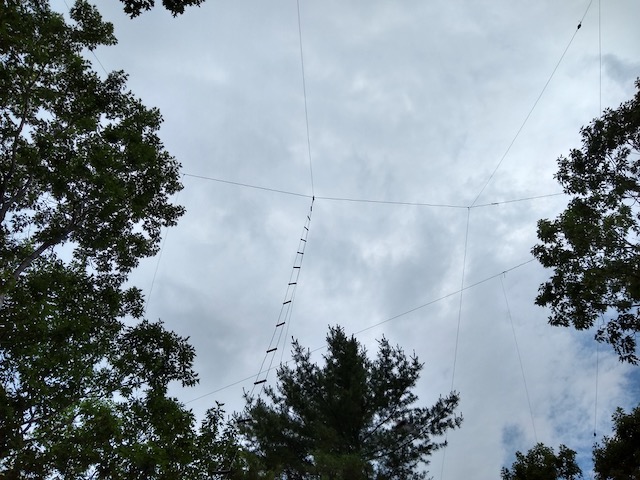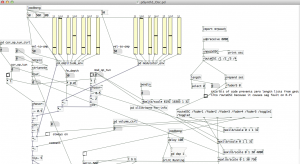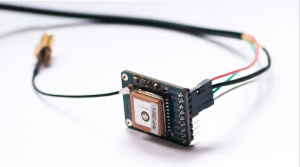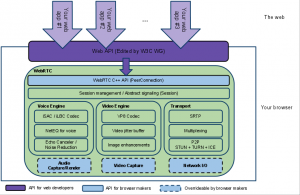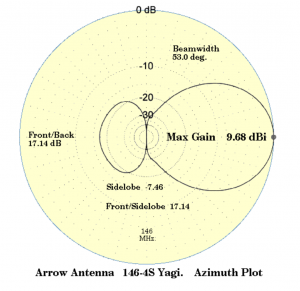Musical stairs
Notes from Gould Academy 2013.
For construction details of the final project see: https://reactivemusic.net/?p=12300
original post
An attempt to collect notes on this project as we bring it to a close.
During Monday’s class I gave students the current version of the Arduino sketch – and showed them how to hack the code which triggers Midi notes. it was amazing to see them make changes to the code, which they barely understood – and then upload their changes into the Arduino to see how it affected the sound of the stairs.
There are two sets of stairs:
- version 1 – built with foam/aluminum foil sensors and a circuit-bent Radio Shack keyboard. (based on a design from a previous life)
- version 2 – was done with Arduino, IR emitter/receivers, an Ethernet shield for data logging,
Here are relevant posts – until the student portfolio presentations begin…
Logging data to Pachube
https://reactivemusic.net/?p=4900
https://reactivemusic.net/?p=5163
Arduino IR beam testing
Raspberry-Pi Osc synthesizer
A variation on the Midi synthesizer from this post: https://reactivemusic.net/?p=4960
The synthesizer was built in PureData (Pd extended) using the visual interface on a MacBook. Then the pd file was run in command line mode on the r-pi. The sound card is a Griffin i-Mic, running at 22.5 Khz sample rate. Although there’s no reason why you couldn’t use the builtin DAC on the r-pi.
The r-pi is connected via the ethernet port to a wi-fi network which receives Osc (Open Sound Control) messages from an iPod running touch-Osc. The network connection could have been made using a USB wifi adapter.
All together the cost of this arrangement (less the iPod) would be less than $50. The software is all open source. The huge financial barriers to working with music synthesis and signal processing, that have been associated with these fields for years, simply don’t exist anymore.
Alternative ways of controlling the synth – if a wiFi router is not available, include:
- USB keyboard (usually free)
- USB Midi Keyboard ($25)
- switches or dials via the GPIO pins (spare parts)
- direct ethernet connection to another device.
Notes:
Pd file: tkzic/rpi/pd/piSynth1_OSC.pd
recieve port is 8000 – and it uses page 1 of the simple touchOSC template
pd-extended -nogui -noadc piSynth1_Osc.pd
Note: there is some special code to prevent seg faults when you go from page 2 to page 1 of the touchOSC template
Here’s a great tutorial on using OSC with Pure Data
http://en.flossmanuals.net/pure-data/network-data/osc/
GPS on Raspberry Pi
Successfully installed this GPS board on the R-Pi.
By Kevin Townsend at adafruit.com
http://learn.adafruit.com/adafruit-ultimate-gps-on-the-raspberry-pi/introduction
The drivers for the console cable were already in the Raspian distribution on the R-Pi.
I installed the gpsd (daemon) software as directed in the above tutorial.
Documentation for gpsd is here:
http://gpsd.berlios.de/client-howto.html
Sample C code is: gpxlogger.c and cgps.c – which can be found in tkzic/rpi/gpsd 3.7/
(todo – write sample code and add to telemetry tracker)
Schwarzonator II
Chord generator and collaboration tool
by Henrik Schwarz at Ableton
webrtc
Real time multimedia web API.
http://www.webrtc.org/reference/architecture
The demo actually works – the audio sounds like an AM radio at night its one of the coolest things I’ve ever heard. Requires latest version of Chrome.
How to improve Skype audio quality
Comprehensive technical data on high quality sound with Skype
http://www.blogarithms.com/index.php/archives/2007/12/23/skype-for-interviews/
Gould musical stairs data
3d sensor from PrimeSense
Near IR + imaging.
70 cm Yagi antennas
Tracking high altitude balloon telemetry on 434 Mhz.
By Arrow antennas
http://www.arrowantennas.com/index.html
Also by Cushcraft:
http://www.gigaparts.com/store.php?action=profile&sku=ZCC-A43011S
